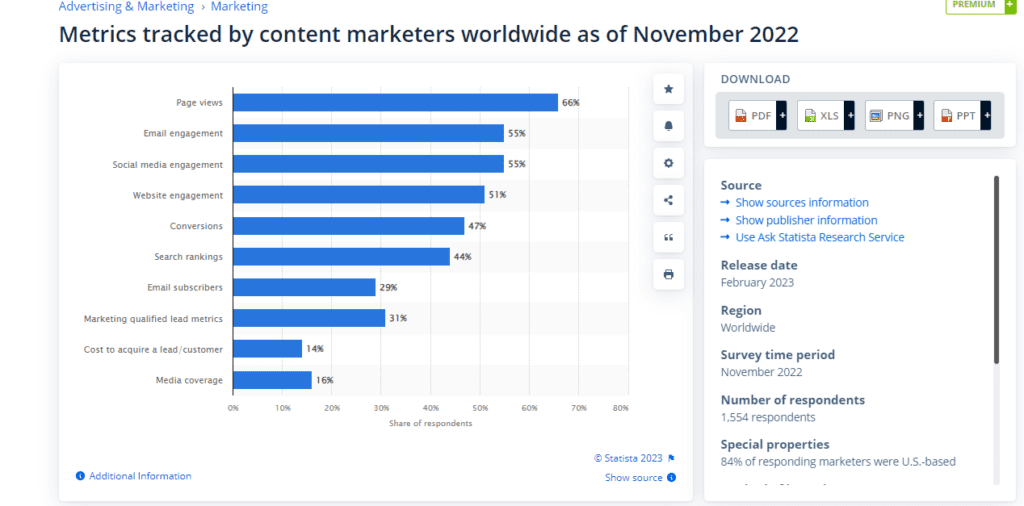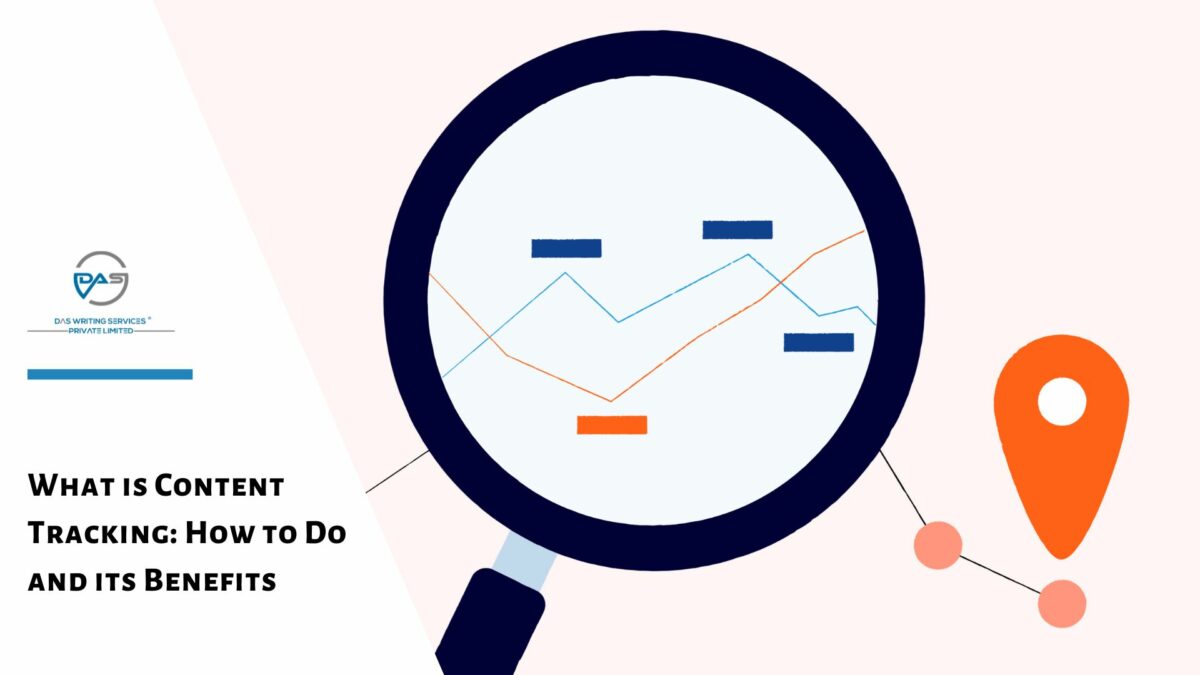Did you know that content tracking can help you in getting a clear idea of what is working for your business and what is not? But first, you need to have at least 20-30 blogs on your website to understand the metrics in detail.
For example, you have 25 blogs on your website. Now if you track them regularly with the help of tools which we have talked about in the later part of the video. You will understand which content is performing and which is not. That can help you in planning out your future blogs in a better way.
According to a survey conducted by SEMRush, 44% of individuals said that improving the quality and value of their content has led to success. This can be done after you meticulously track your content and understand what is working in your favour.
We have talked about what is content tracking and how is it important for your business in detail below. You can go through the different sections to understand all about it.

What is Content Tracking?
Content tracking is the process of monitoring and managing digital content to gain insights into its performance, distribution, and engagement across various platforms and channels.
It involves using specialised tools and techniques to track the reach and impact of content, ensuring its effectiveness in achieving organisational goals.
Content tracking is essential for businesses, content creators, and marketers to optimise their content strategies, understand audience behaviour, and make data-driven decisions. The detailed list of importance is mentioned in the section below.
It is important for creators or business owners to work on continuously creating content in order to successfully implement digital content tracking.
What is the Importance of Content Tracking?
1. Performance Evaluation
Content tracking allows businesses to assess how well their content is performing. Metrics like views, clicks, shares, and conversions help gauge the success of different content pieces and identify areas for improvement.
2. Audience Insights
Understanding your audience is crucial for creating relevant content. Content tracking provides valuable data on audience demographics, preferences, and behaviour, enabling content creators to tailor their material to better resonate with their target audience.
3. Optimisation Opportunities
By analysing content performance, businesses can identify successful content formats, topics, and distribution channels. This information helps them optimise their content strategy to drive better results.
4. Competitor Analysis
Content tracking also involves monitoring competitors’ content efforts. By analysing their performance, strengths, and weaknesses, businesses can gain insights to refine their own content strategy and stay ahead in the market.
5. Content Distribution
Tracking content across various channels helps businesses understand which platforms yield the best results. This knowledge allows them to focus their efforts on channels that generate higher engagement and reach.
6. ROI Measurement
Content tracking helps measure the return on investment (ROI) of content marketing efforts. It enables organisations to determine if the resources allocated to content creation and promotion are yielding the desired outcomes.
7. Content Security
For content creators and publishers, tracking their content online helps identify instances of unauthorised use or plagiarism. This allows them to take appropriate action to protect their intellectual property rights.
8. Decision-Making
Data obtained from content tracking empowers businesses to make informed decisions regarding content creation, distribution strategies, and budget allocation.
9. Real-Time Monitoring
Content tracking tools often provide real-time monitoring, allowing businesses to respond quickly to emerging trends, issues, or opportunities.
10. Continuous Improvement
The insights gained through content tracking support a cycle of continuous improvement, where content strategies are regularly refined and optimised based on data-driven analysis.
What are the Dos and Don’ts of Content Tracking?
Blog tracking, also known as blog analytics, involves monitoring and analysing data related to your blog’s performance and audience engagement. By tracking various metrics, you can gain valuable insights that will help you improve your blog’s content, reach, and overall effectiveness. Here are some do’s and don’ts to consider when it comes to blog tracking:
Do’s:
1. Set Clear Goals
Before you start tracking your blog’s metrics, define specific goals you want to achieve. Whether it’s increasing website traffic, improving user engagement, or boosting conversions, having clear objectives will guide your tracking efforts.
2. Use Web Analytics Tools
Utilise web analytics tools like Google Analytics to track key metrics such as page views, bounce rate, time on page, and conversion rates. These tools provide valuable data to understand your audience and blog performance.
3. Monitor Traffic Sources
Track where your blog traffic comes from, such as search engines, social media, referral sites, or direct visits. Understanding traffic sources helps you identify which channels are driving the most visitors to your blog.
4. Analyse Audience Demographics
Use analytics tools to learn more about your blog’s audience, including their age, gender, location, and interests. This information helps you create targeted content and tailor your marketing efforts.
5. Track Popular Content
Identify your most popular blog posts regarding views, shares, and comments. Analyse what makes these posts successful and replicate those elements in future content.
6. Monitor Conversion Metrics
If your blog has specific conversion goals (e.g., newsletter sign-ups, purchases), track the conversion metrics to assess the effectiveness of your calls-to-action and overall conversion rate.
7. Implement UTM Tracking
Use UTM parameters to track the effectiveness of your marketing campaigns and promotions. This helps you identify which campaigns are driving the most traffic and conversions.
8. Track User Behaviour
Analyse user behaviour on your blog, such as click-through rates, scroll depth, and exit pages. This data provides insights into how users interact with your content and identify areas for improvement.
Don’ts:
1. Do not Rely on Vanity Metrics Alone
While metrics like pageviews and social media like to provide a quick overview, they may not reflect true engagement. Combine them with other relevant metrics to gain a comprehensive understanding of your blog’s performance.
2. Do not Ignore the Bounce Rate
A high bounce rate indicates that visitors are leaving your blog after viewing just one page. Investigate the reasons for a high bounce rate and take corrective actions to improve content relevance and user experience.
3. Do not Track Too Many Metrics
Avoid tracking every single metric available. Focus on key performance indicators (KPIs) that align with your goals. Overwhelming yourself with data can lead to analysis paralysis and make it harder to make informed decisions.
4. Do not Disregard Mobile Users
Ensure that your blog is mobile-friendly, and track how mobile users interact with your content. Mobile traffic is significant, and ignoring it can impact your overall performance.
5. Do not Track Irrelevant Data
Stay focused on metrics that align with your blog’s purpose and objectives. Irrelevant data can clutter your analysis and distract you from meaningful insights.
6. Do not Track Data Infrequently
Regularly review and analyse your blog’s performance. Tracking data consistently allows you to spot trends, address issues promptly, and make timely adjustments to your content strategy.
By following these do’s and don’ts, you can effectively track your blog’s performance, understand your audience, and optimise your content to achieve your blogging goals. Remember that data analysis is an ongoing process, and insights gained from tracking should inform your content strategy and decision-making.
Best Content Tracking Tools for Your Website
Content tracking ways are necessary for tracking and analysing the performance of your digital content across numerous platforms and channels. These tools give you useful information and insights that can be used to improve your content strategy and make better decisions. Here are a few popular content-tracking tools for you to consider about:
1. Google Analytics
Google offers this effective web analytics tool. It keeps track of user interactions on your website and offers insightful data about user behaviour and website functionality. The number of page views, sessions, bounce rate (the percentage of visitors who leave after viewing just one page), average time on page, and conversion rate (the percentage of visitors who successfully complete a specific goal, such as signing up for a newsletter or making a purchase), are just a few of the metrics that can be tracked with Google Analytics. The application also provides demographic information about the audience, such as age, gender, interests, and geography.
Google Analytics enables you to learn more about how visitors discover and interact with your content, the most popular sites, and the marketing strategies that result in the highest traffic and conversion rates.
2. SEMrush
SEMrush is a thorough digital marketing tool with content tracking capabilities. Although SEMrush is well renowned for its SEO capabilities, it also offers information on the effectiveness of content. You may use it to watch your content’s keyword ranks, find the best-performing material, and examine traffic and social media interaction analytics. You can find possibilities to optimise your content strategy and raise your search engine exposure by keeping track of how your content performs for particular keywords and contrasting it with the content of your rivals.
3. BuzzSumo
BuzzSumo is a content research tool that enables you to find widely shared material in your sector. It enables you to monitor the effectiveness of both your own and your competitors’ material. You may use BuzzSumo to assess how well your content is doing in terms of backlinks, social media shares, and general engagement metrics. To guide your content creation approach, you may also find influential content providers in your niche and track down hot subjects.
4. Moz Pro
A package of SEO tools called Moz Pro has features for tracking content. It offers perceptions of the performance of content, on-page SEO, and website rankings. You can track the development of your backlink profile, see how well your content is ranking for particular keywords, and find ways to increase its search engine exposure with Moz Pro’s content tracking capabilities.
5. Hootsuite
This is a well-known social media management tool that helps you to plan and distribute content across a number of social networks. Hootsuite offers social media analytics in addition to its content scheduling capabilities. Your social media posts can be monitored for performance using metrics like impressions, clicks, likes, comments, and shares. With the aid of these insights, you can better comprehend the types of material that appeal to your audience and adjust your social media content strategy as necessary.
6. Ahrefs
Although its backlink analysing capabilities are what it is most well-known for, it also has content-tracking functions. You may watch organic traffic, keep track of keyword ranks for your content, and examine backlinks to it with Ahrefs. With the aid of these insights, you can better understand how search engines respond to your content and pinpoint its weak points.
Before selecting the one that best fulfils your content marketing objectives, it is crucial to evaluate your particular requirements and budget because each of these content monitoring tools has a different function. Many of those tools allow you to explore their features and determine which one best meets your needs through free trials or limited-time free editions.
In conclusion, content tracking is a vital aspect of modern content marketing and publishing. By monitoring content performance and audience engagement, businesses and content creators can enhance their strategies, reach the right audience, and achieve their goals effectively.
A lot of people do not understand that to track content first you need to have quality content posted on your website. You can contact us for your content related needs and we will provide you with a free sample to get started.
FAQs
1. What is the UTM method in content tracking?
Urchin Tracking Module (UTM) codes are small pieces of text added at the end of a URL to improve content marketing campaign tracking.
2. Can a content writing company do content tracking for my website?
Some companies do keep track of the content they have written for your website. You should contact them and understand the process in detail to avoid miscommunication.
3. Will the free content tracking tools work as efficiently as paid ones?
This totally depends on the tool and also your objective. For example, some tools have no paid version so they provide you with the best results free of cost. Whereas, some tools provide additional features in the paid version. So you should one according to your needs.





Leave a comment
All comments
Arghish Das
This is a really helpful article! It's great for anyone who wants to improve their content strategy. How can I use data to make my content better without losing my creativity? Thanks for sharing!